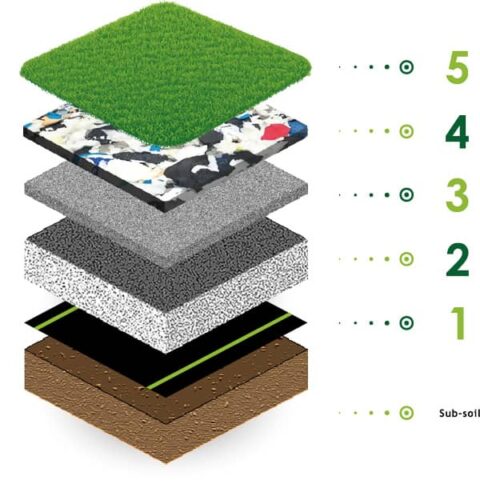Excavation
The first task is to remove the grass. This can be done with either a turf cutter or a sharp turf spade. Then continue to excavate until we find a solid base. Once you are suitably happy that the ground is solid under foot you can then compact the ground. This can be done with a whacker (vibrating plate) or simply using the back of a spade.
Perimeters
For your perimeters, you will require a standard 4″ x 1″ tanalised wood and 18-inch ground stakes. Using these stakes, insert them into the ground around your agreed perimeter and fix the wood to the stakes. You can have your perimeters set into the ground or raised to create a wrapped grass edge effect. Remember – the higher your edges – the more aggregate you require. You should screw the wood to the stakes (not nail) as this will provide a much stronger grip.
When fitting up to edges such as block paving or stone slabs, the wood should sit below the depth of the slab according to the pile height of your chosen grass. This will mean your grass should be level with the height of the slab. You may encounter problems when passing any materials set in concrete. Our specialist fitters are trained to remove these obstacles using specialist tools.
Back Fill
Depending on the depth of your excavation we would back fill with a compacting fines aggregate. This can either be granite dust (grano), sharp sand, grit sand or limestone dust. If we have had to excavate over 3 inches we would use a two tier back fill. We then cover two thirds of the depth with a crush and run aggregate – otherwise known as “type 1”. This is standard compacting aggregate and can be purchased from any reliable Builders Merchants.
The final third is covered by a fines aggregate (as already mentioned). The aggregate should be applied evenly made compact until it is solid. Look over the area and then remove any troughs and crests with the back of a rake or brush. To ensure no plant life grows back you should spray the area with a complete weed and plant killer. NOTE – the aggregate should reach the top of your wood perimeter.
Lay & Seam
The pieces should ideally be rough cut to size allowing for 20 centimetres all round. Then move them into position. When seaming two pieces together you need to remove the excess from the sides of the grass. Butt the two pieces together and work around the seam until it is invisible . Once you have done this for all seams, rest weights across the seams so the grass cannot move and won’t rough cut the perimeter.
Remember to wrap the grass over the wood and cut at the foot of the wood. You can then lightly tack the perimeter before setting the seams.
Open up your seam and slide the tape right under it. Apply glue to the tape, slowly fold down the sides working from one side to the other. Once this is done this you can walk down the seam to add weight and push the grass onto the tape, making sure the grass does not separate or crest if too close. You can now continue to nail in the remainder of the perimeter.



